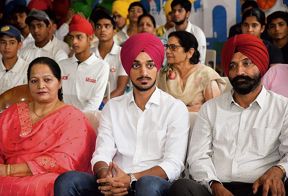In Pursuit of Peace: India-Pakistan Relations Under Six Prime Ministers by Satinder Kumar Lambah. Penguin Random House. Pages 384. Rs 799
Book Title: In Pursuit of Peace: India-Pakistan Relations Under Six Prime Ministers
Author: Satinder Kumar Lambah
Vivek Katju
NO Indian diplomat had as extensively dealt with Pakistan as the late Satinder Lambah, who joined the Indian Foreign Service in 1964. His book, ‘In Pursuit of Peace: India-Pakistan Relations Under Six Prime Ministers’, published posthumously, covers India-Pakistan ties since the partition of the Indian sub-continent. It especially focuses on his own vast experience — as India’s High Commissioner and Deputy High Commissioner in Pakistan, as Joint Secretary (Pakistan and Afghanistan) and as Prime Minister Manmohan Singh’s special envoy involved in a long period of back-channel negotiations — in assisting the country’s leadership in managing this complex and deeply troubled relationship. His book also reveals that his advice was sought on Pakistan-related issues even when he was on assignments unconnected with that country. He was also Manmohan Singh’s special envoy on Afghanistan.
Lambah came from a prominent and affluent Peshawar family. That, and his social skills, helped him foster close ties with a large number of influential Pakistanis, especially from the Punjab and Khyber-Pakhtunkhwa province. He also got to know Benazir Bhutto. This provided him great access to influential Pakistani social and political circles. That obviously helped him in managing situations and conveying Indian thinking on bilateral issues. But social and political contacts and goodwill are of little diplomatic use when they are most needed. This is well-illustrated by the lack of response of Prime Minister Nawaz Sharif and Interior Minister Shujat Hussain, both of whom he knew well, to his attempts at contacting them when the Indian Consul-General’s residence in Karachi was being attacked, with the CG’s family present in the house, in December 1992. Lambah gives a detailed and nostalgic account of how hospitably those who knew his and his wife’s family in Pakistan received them. All this makes for good reading, but is of little import in inter-state relations.
Lambah shows great understanding of the evolution and orientation of the Pakistan state, especially its army. He correctly notes: “Whereas Pakistan continues to derive the rationale for its existence to Islam, it has been able to sustain itself all these years through the creation of a bogey in the form of an Indian threat.” Despite this essential aspect of the country, many Indian Prime Ministers have chased the chimera of peaceful and cooperative ties with such a state. To translate this desire into reality, Lambah was the preferred diplomat of many of them. He gives excellent and succinct accounts of these attempts, including the creation of a Joint Commission to create a network of cooperative ties, but Pakistan showed no real interest in pursuing this track.
For India’s Pakistan watchers, the most rewarding, and ironically also the most frustrating, part of the book is Lambah’s back-channel interactions, from 2005 to 2014, with his Pakistani interlocutors to address the Jammu and Kashmir issue. Prime Minister Manmohan Singh was obviously determined to finalise an agreement on the basis of what Lambah lists as 14 “principles, prerequisites and outcomes”. These adopted a radically different approach from that taken by India in the 1962-63 talks and the believed understanding between Indira Gandhi and Zulfikar Ali Bhutto in Shimla in 1972. On his part, President Pervez Musharraf had spelt out four points. Neither of these were officially ever made known. Lambah lists the 14. The first three of them are:
1) There cannot be any redrawing of borders.
2) No joint sovereignty.
3) LoC has to be respected like a normal border between the two countries.
The implicit political contradictions between these principles are obvious even if some prominent Indian legal personalities consulted by Lambah said that the agreement reached on the back channel did not violate the Indian Constitution.
Taken together, these points indicate that while the de-jure Indian position that the entire erstwhile state of J&K was an integral part of India would remain, de facto, the LoC would become the border, even if it was soft with the movement of people and trade taking place between parts of the state under India’s control and PoK and the northern areas. This would have meant that India would have had to reiterate, whenever required, that the entire state was under Pakistan’s illegal and forcible control and Pakistan would have to maintain that it remained disputed. Could the structures sought to be created manage these constraints?
Lambah records that he met Manmohan Singh 68 times and his Pakistani interlocutors 27 times. However, as he does not disclose what transpired in these discussions, it is impossible to assess how the two countries would have handled this and other thorny issues. Besides, where would the integrative processes have led the entire J&K to? Was that considered?
Lambah indicates that the agreement on the back channel is ready and can be revived. That now seems impossible after the constitutional changes of August 5, 2019, when the government also emphasised India’s claims to the territories of the now Union Territories that are in Pakistani and Chinese control.
The contradictions between Lambah the hard-headed realist on Pakistan and Lambah the ever-trying diplomat to fulfil the wishes of the hopeful PMs is apparent in the book. The question is whether Lambah the analyst came to the fore with a PM. For that, the publication of his diaries will have to be awaited.














